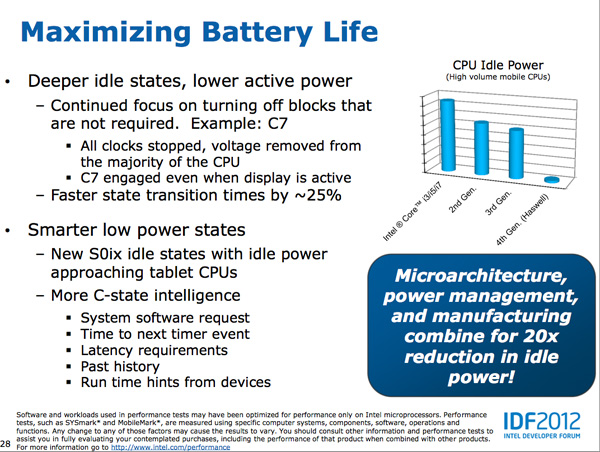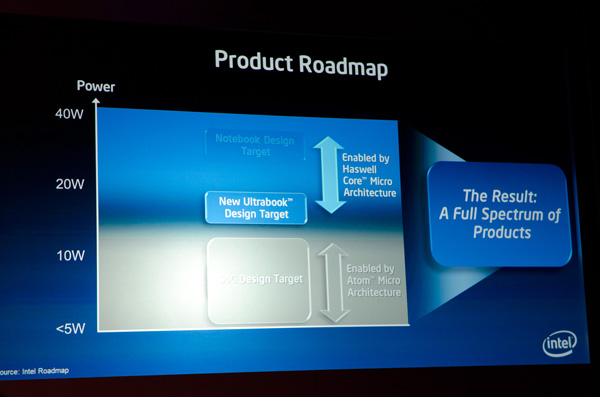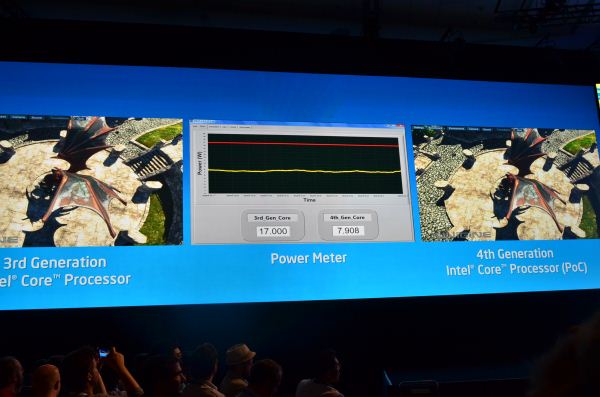Intel's Haswell Architecture Analyzed: Building a New PC and a New Intel
by Anand Lal Shimpi on October 5, 2012 2:45 AM ESTOther Power Savings
Haswell's power savings come from three sources, all of which are equally important. We already went over the most unique: Intel's focus on reducing total platform power consumption by paying attention to everything else on the motherboard (third party controllers, voltage regulation, etc...). The other two sources of power savings are more traditional, but still very significant.

At the micro-architecture level Intel added more power gating and low power modes to Haswell. The additional power gating gives the power control unit (PCU) more fine grained control over shutting off parts of the core that aren't used. Intel published a relatively meaningless graph showing idle power for standard voltage mobile Haswell compared to the previous three generations of Core processors.
Haswell can also transition between power states approximately 25% faster than Ivy Bridge, which lets the PCU be a bit more aggressive in which power state it selects since the penalty of coming out of it is appreciably lower. It's important to put the timing of all of this in perspective. Putting the CPU cores to sleep and removing voltage/power from them even for a matter of milliseconds adds up to the sort of savings necessary to really enable the sort of always-on, always-connected behavior Haswell based systems are expected to deliver.
Intel has also done a lot of work at the process level to bring Haswell's power consumption down. As a tock, Haswell is the second micro-architecture to use Intel's new 22nm tri-gate transistors. The learnings from Ivy Bridge are thus all poured into Haswell. Intel wasn't too specific on what it did on the manufacturing side to help drive power down in Haswell other than to say that a non-insignificant amount of work came from the fabs.
The Fourth Haswell
At Computex Intel's Mooly Eden showed off this slide that positioned Haswell as a 15-20W part, while Atom based SoCs would scale up to 10W and perhaps beyond:
Just before this year's IDF Intel claimed that Haswell ULT would start at 10W, down from 17W in Sandy/Ivy Bridge. Finally, at IDF Intel showed a demo of Haswell running the Unigen Heaven benchmark at under 8W:
The chain of events tells us two things: 1) Intel likes to play its cards close to its chest, and 2) the sub-10W space won't be serviced by Atom exclusively.
Intel said Haswell can scale below 10W, but it didn't provide a lower bound. It's too much to assume Haswell would go into a phone, but once you get to the 8W point and look south you open yourself up to fitting into things the size of a third generation iPad. Move to 14nm, 10nm and beyond then it becomes more feasible that you could fit this class of architecture into something even more portable.
Intel is being very tight lipped about the fourth client Haswell (remember the first three were desktop, mobile and ultra-low-volt/Ultrabook) but it's clear that it has real aspirations to use it in a space traditionally reserved for ARM or Atom SoCs.
One of the first things I ever heard about Haswell was that it was Intel's solution to the ARM problem. I don't believe a 10W notebook is going to do anything to the ARM problem, but a sub-8W Haswell in an iPad 3 form factor could be very compelling. Haswell won't be fanless, but Broadwell (14nm) could be. And that could be a real solution to the ARM problem, at least outside of a phone.
As I said before, I don't see Haswell making it into a phone but that's not to say a future derivative on a lower power process wouldn't.













245 Comments
View All Comments
dishayu - Friday, October 5, 2012 - link
I derived immense pleasure reading the article. Thank you, Anand. Big ups for the comprehensive read.My thoughts :
I think Intel really dropped the ball by not having unlinked clocks for each core, like qualcomm has for it's s4 pro processors. There are so many times that, for instance, i have a page open with some animated GIFs. They are strictly single thread processes and they won't let the processor go to idle state. And this is a very VERY common occurance that can IMO, only be solved by adopting unlocked states for each core. 3 cores can stay in sleep state (almost perpetually) and the processor runs on a single core with lowered frequency. THAT would be power efficient.
dagamer34 - Friday, October 5, 2012 - link
Uhh... isn't turning off unused cores and overclocking the 4th core within TDP to perform single threaded tasks exactly what Turbo Boost introduced in Sandy Bridge is?know of fence - Friday, October 5, 2012 - link
Reducing power is great and also inevitable, but Intel's move to compete against everything and everybody is alarming. With everyone trying to follow/please Apple, that means nothing good for the consumer, throw-away luxury electronics for exceptionally well groomed masses.Also, isn't it too early to be hyping this stuff?
A5 - Friday, October 5, 2012 - link
Intel has to compete against ARM to keep them from taking over the "good-enough" computing space.As for the rest of it, you're not making any sense.
jjj - Friday, October 5, 2012 - link
The ARM problem is not about the product but about price, long term the CPU/SoC ASP will drop hard ,there is competition now. Servers will keep them on life support for a while but without fundamental changes to their business model they can't make it.Intel should remember how they won the market .
dishayu - Friday, October 5, 2012 - link
It's about both. Intel does not have sufficinetly low power parts at all, regardless the price point.mrdude - Friday, October 5, 2012 - link
Regardless of whether they step foot into that end of the spectrum or not (and by Anand's analysis that's more likely with Broadwell and on?), they still need to compete on price.It's one thing to make a chip, it's quote another to make it competitive with respect to pricing. What works against a distant AMD won't work against ARM.
DesDizzy - Sunday, October 7, 2012 - link
I agree. This seems to be something that most people overlook when addressing the Wintel monopoly. The costs of Wintel products are high within the PC/Laptop space. The price of ARM/Apps are cheap within the Smartphone/Tab space. How do Wintel square this circle without damaging their business model?Krysto - Friday, October 5, 2012 - link
You may not agree with Charlie, Anand, but reality seems to agree with him:http://www.techradar.com/news/computing/apple/appl...
I really don't know how you can think Apple would ever start using Intel chips in their iPads when Apple has already proven they want to make their own chips with A6.
Also, according to Charlie, Haswell will be like 40% more expensive than IVB. Atom tablets already seem to start at like $800. So I wish Intel good luck with that. Ultrabooks and Win8 hybrids won't drop down in price any time soon.
http://semiaccurate.com/2012/10/03/oems-call-intel...
Penti - Friday, October 5, 2012 - link
I don't know how you could fail so much in reading comprehension, Anand only said the same flying spaghetti monster-damn form factor. Nothing else. There also must be an ecosystem, but if you can run the same app on a tablet as well as a desktop on x86 with more performance then ARM why wouldn't you see vendors use it. It is a full system even capable of building itself. It's not about killing ARM. Intel still uses it, they need fairly high-performance RISC chips for stuff like baseband. They had a large markets in smart-phones before 2006 and they made the choice to sell it because they had Atom in their lineup. They didn't forget about it.It's Microsoft tablets that costs 500-900 dollars even on Atom, but they only need to compete with Windows RT which is totally retarded as far as corporate customers go and not the same system as 8 Pro, doesn't run the same software. An Android tablet could use a Z2460 (and coming Z2580, after that Valleyview SoC's) and build a 240 dollar tablet. There is no price difference to be had as far as hardware is concerned. Windows 8 tablets are a whole other form factor and device to begin with. Most will have keyboard and multitouch trackpad.
He only talks about the same form factor, size and battery life here. In the Microsoft ecosystem there is really no reason to go to Windows RT powered ARM-devices which doesn't have better performance and runs no third party desktop (Win32/Full Windows SDK) software. It also lacks the same features in other areas which makes them devices instead of general computing platforms. Remember they offer both here. Hell the built in email is even worse then the one built into Android since version 3.0 or so, it's a lot worse then Third party mail-clients in Android, it's worse then mail-clients in Blackberry 10, Symbian, iOS and so on. If your replacing a desktop your not going with ARM here, not on a Windows device at least, Anand only talks about a new bread of DTR Tablets and Ultra-portables that will fit in the same form factor and battery life scenarios as ARM-tablets. Apple certainly don't need to participate here.
Intel certainly has sales to be made if they move Haswell down to low-power Atom territory when it comes out later next year. They could be used as the only computing device you have (smartphone + hybrid tablet-pc). Replacing desktops, ARM/ATOM-tablets, media PCs for your TV (just stream with Miracast). Et cetera. ARM-devices would just be cheaper less capable devices there. But it's still different targets. Haswell still targets server (enterprise-market), desktop, notebooks with larger form-factor/power-usage, as well as more portable stuff. Atom is still for the handheld stuff you use with one hand. ARM has moved quiet fast but they have no reason to target high-performance applications or built 100W SoC's that is fast without parallel computing. Applications like high-performance routers for example still uses licensed and custom MIPS and PowerPC chips. There are plenty of markets where a full feature ARM Cortex or x86 won't work either. ARM is just moving into the multimedia-field, replacing customs architectures in TV's, displacing MIPS, PPC etc. If Apple builds a very large custom CPU-architecture compatible with ARM ISA for workstations, notebooks etc they will just be in the same position they were with PowerPC and have to compete with the high-performance chips that most can't compete with, even with much larger resources then Apple. Apple and Samsung has no reason in doing so outside handheld devices, low-power servers, consumer oriented routers, streaming media boxes which leaves plenty of room for Intel and all the rest. Plus WiFi and wireless baseband in a huge market in of it self and it doesn't matter what the application processor architecture is. Stuff like ARM has competed because you could replace previous products with it easily, thus taking some of the SoC-market away from other, but that coincides with the choice to do so.